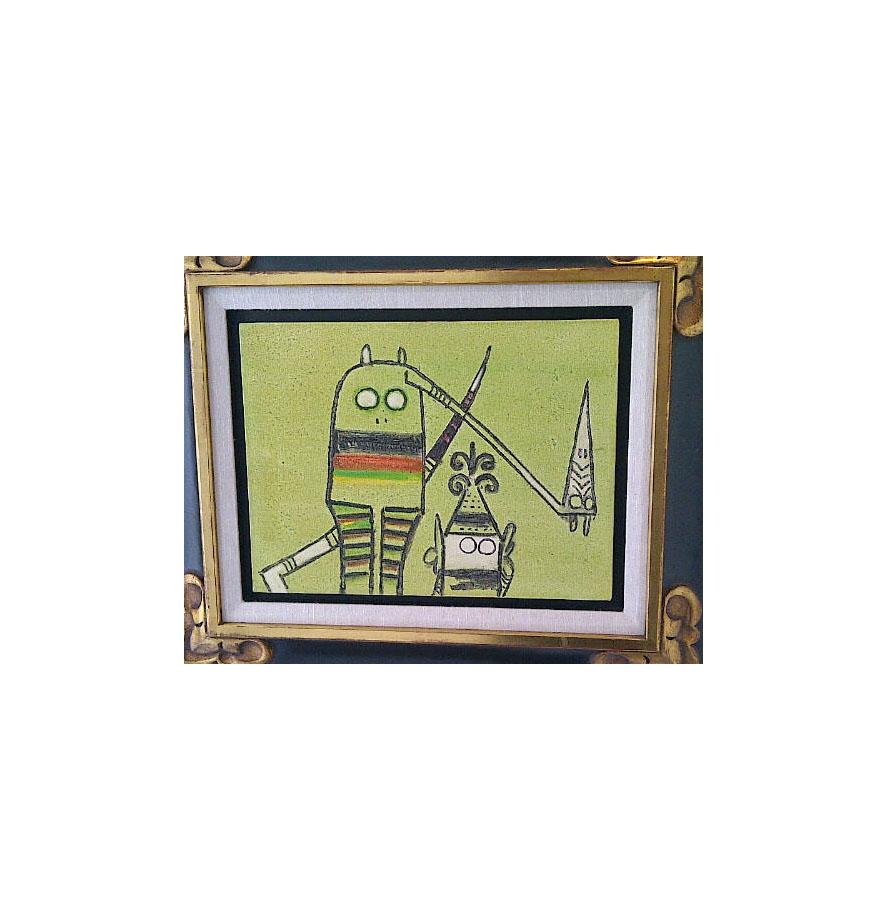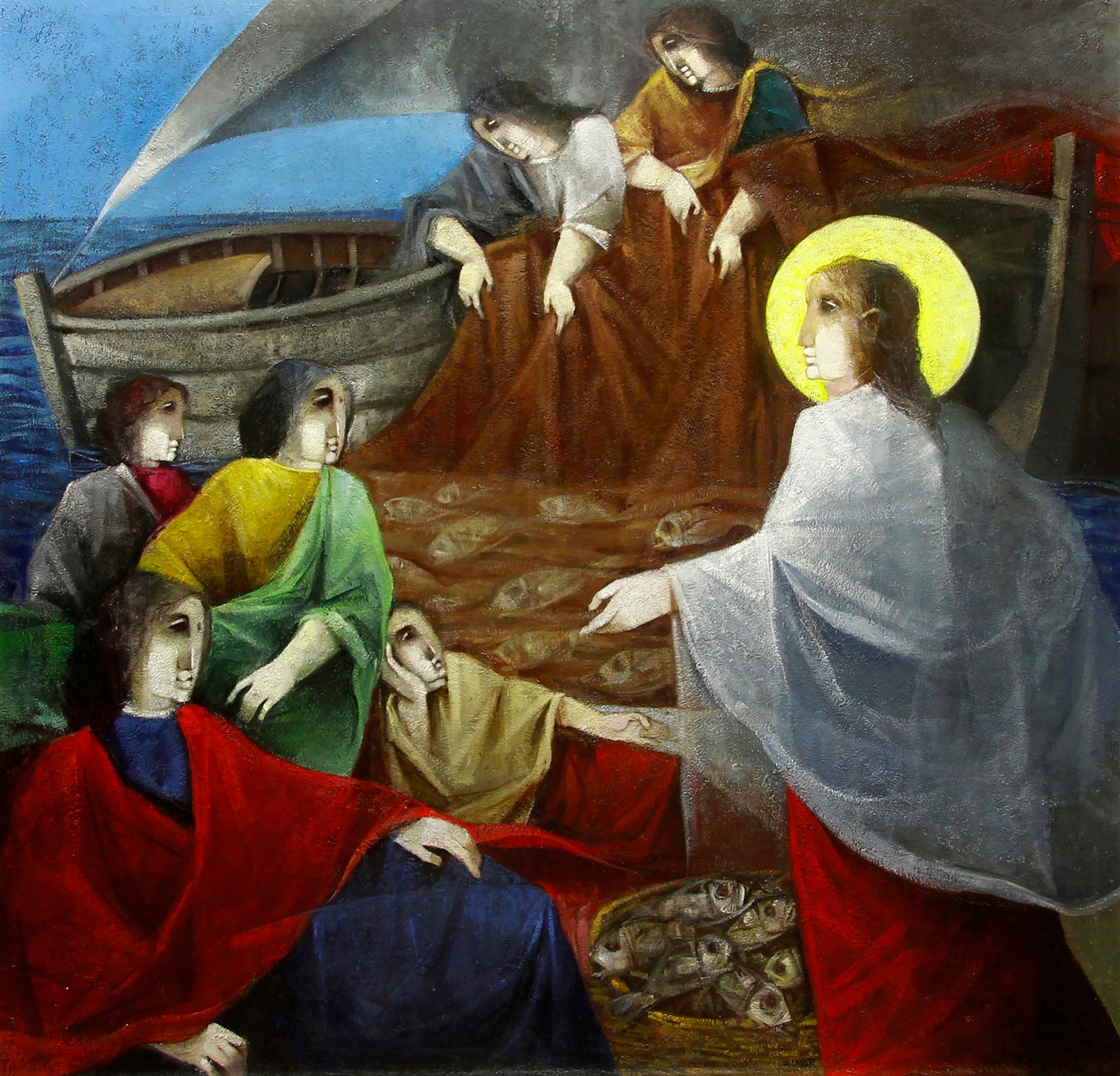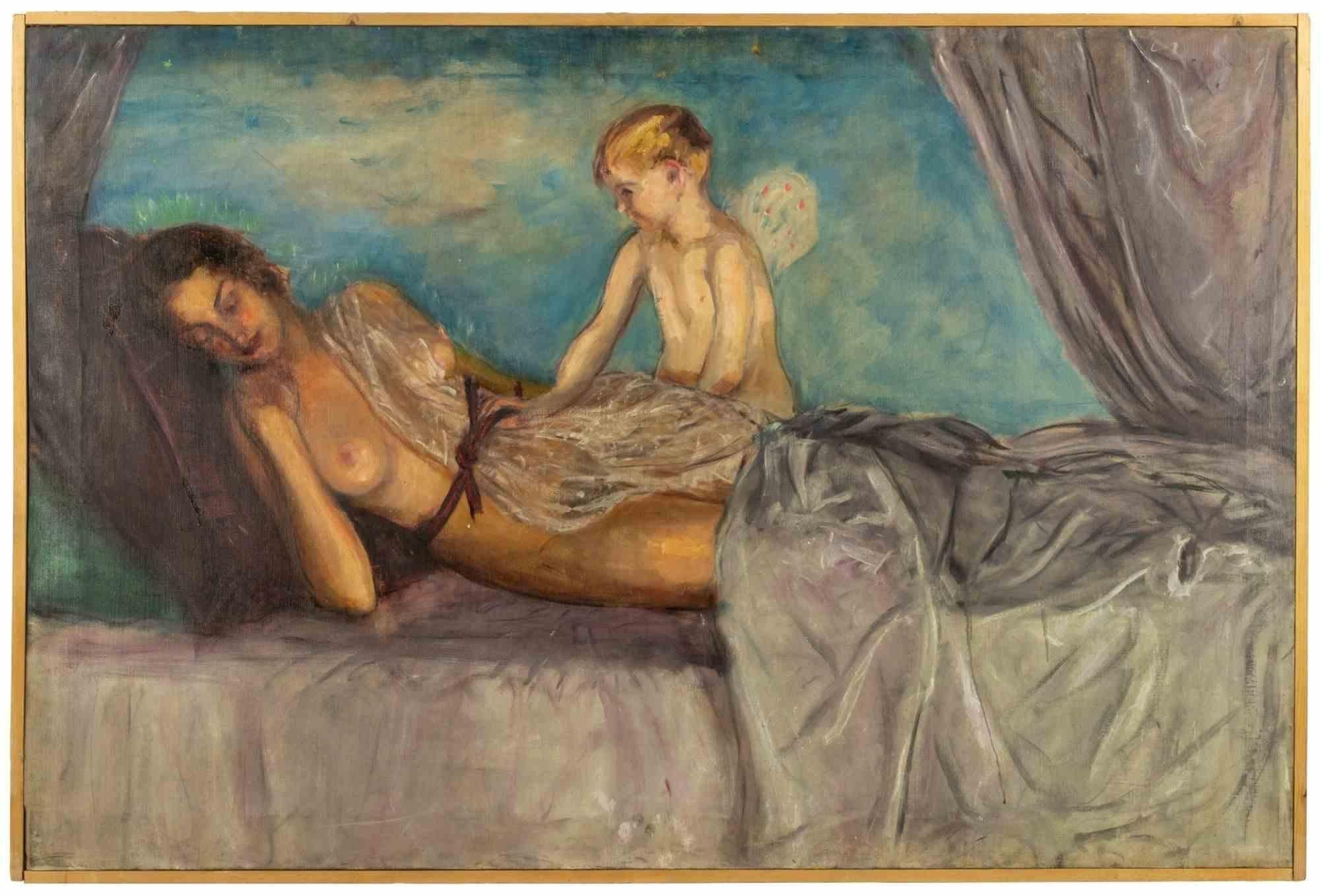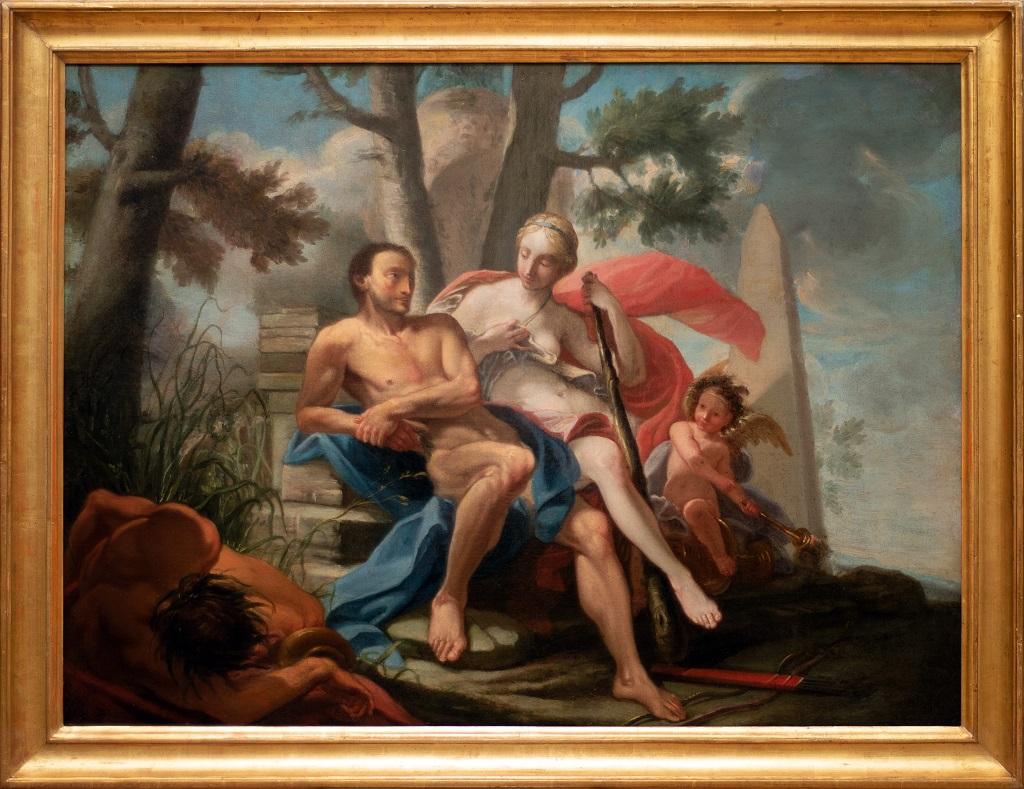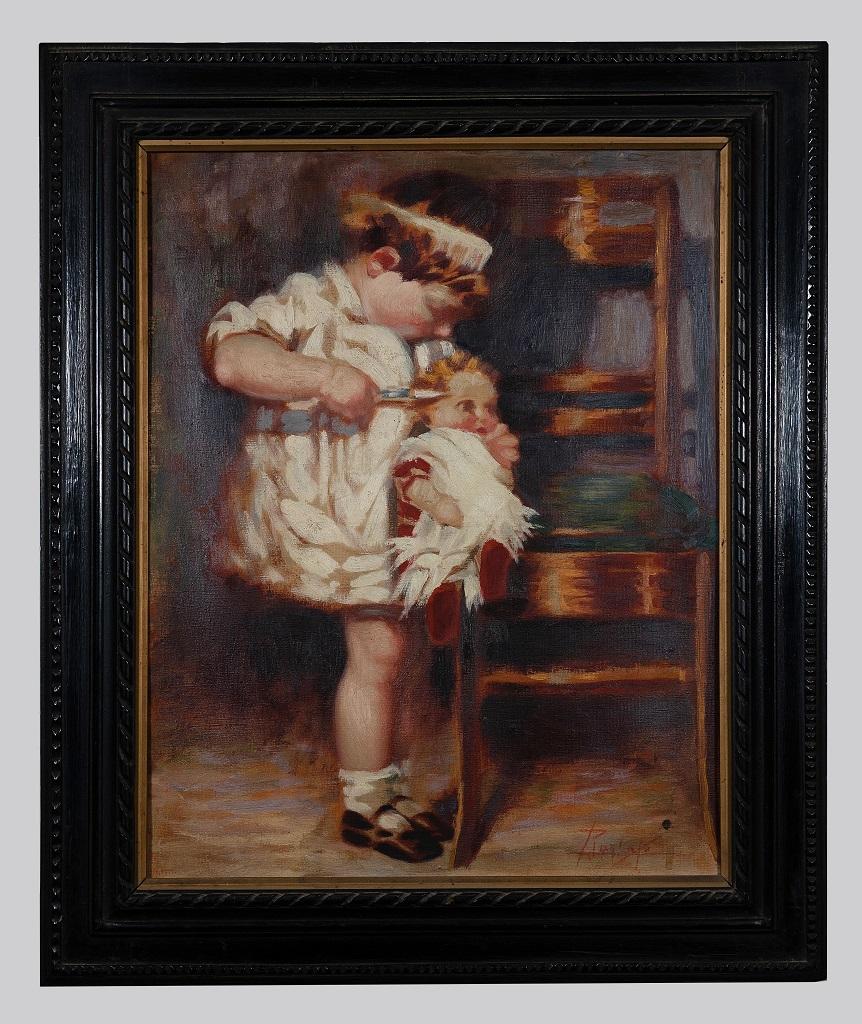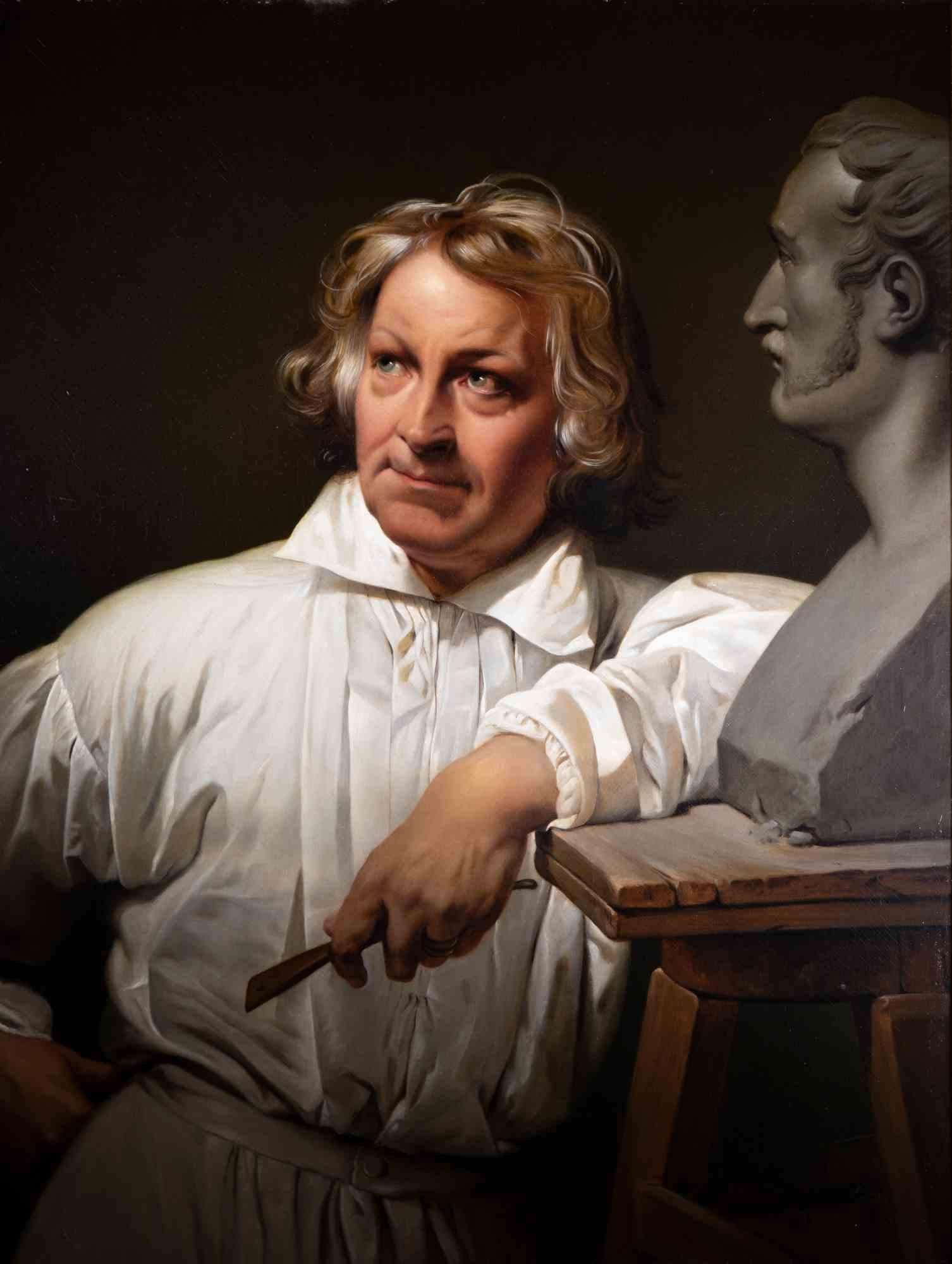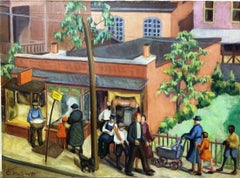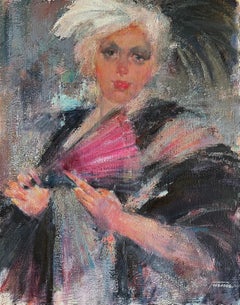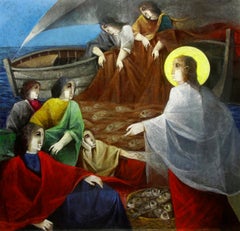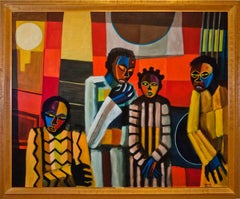
SERENADE FOR A SEAMSTRESS
View Similar Items
Want more images or videos?
Request additional images or videos from the seller
1 of 5
Shubert DenisSERENADE FOR A SEAMSTRESS1985
1985
About the Item
About the Seller
5.0
Vetted Seller
These experienced sellers undergo a comprehensive evaluation by our team of in-house experts.
Established in 1972
1stDibs seller since 2011
384 sales on 1stDibs
More From This SellerView All
- Shopping DayLocated in Los Angeles, CA> > Painter George Melville Smith (1879-1979) Painter, illustrator born in Chicago. Smith began formal art studies at the School of the Art Institute of Chicago at the age of seventeen, after first studying as an architect's apprentice. In 1925-26 he studied in Paris under Andre Lhote, then worked as a painter in France, Spain, England and Italy. He exhibited at the Art Institute of Chicago four times during the 1930s, and was included in the Whitney Museum's 1933 exhibit which also featured Grant Wood...Category
1930s American Modern Figurative Paintings
MaterialsOil, Canvas
- LADY WITH PICK FANLocated in Los Angeles, CABiography from the niece of the artist from during his lifetime. Paintings acquired from the artist.s estate. Max Turner 1925 - 2019 Max Lamar Turner Painter, Sculptor, Teacher and Author. Max Turner was born in Omaha, Nebraska on July 28, 1925. His father was Lance Howard Turner and his mother Mary Irene Turner. In 1927, his family moved to Bingham Canyon, Utah where Max's father extracted copper from a creek that he had diverted to pass through his garage. The town was located in a narrow canyon on the eastern face of the Oquirrh Mountains. In 1938, when Max was 13, his family moved to Midvale, Utah. After completing high school, Max went to work laying rail until he was inducted into the U.S. Navy to serve during W.W. II. There he took an aptitude test and was initially assigned to the medical corp., later transferring to the dental unit. Max was stationed at Port Hueneme, Ventura County, California through the end of the war. When he was discharged in 1946, he remained in Southern California, living in the Los Angeles area. He met a man named Larry Torres and they formed a partnership to do silk screen work primarily for the Colby Poster Printing Company. This lasted about 10 years until the Colby building caught fire and burned down. In 1958, Max began working for Slade Novelty company that made doll parts using a product called plastisol. A year later, Max began producing plastic parts through his own business. One day, a couple of kids brought in a shrunken skull they had made and asked Max if he could reproduce it. Max said he could and he looked around for a business to work with for this task. He ultimately decided he could create his own machine shop to make molds. As a result, Max purchased a lathe, drill press, grinder and other tools to create his own machine shop and went into business making molds. He built a clientele and in 1973, he moved his machine shop to Glendale, California. Painter, Sculptor, Teacher and Author: Max recalls the day when his interest in art took a new direction. He happened to be in a paint store to purchase some supplies when he saw a card posted on a wall that read, "Come paint with Connie Marlo". Max had been interested in art since his youth and he was frequently impressed with paintings displayed by local artists at various community events. Consequently, he decided to go to Connie's Saturday morning art class at a studio on North La Brea Avenue (between Sunset and Hollywood) in Los Angeles. But, as fate would have it, he immediately took a detour from this class when he found a piece of paper on the floor of the studio referencing another art class dealing with compositions, patterns, rhythms and color harmony. The instructor's name was Hal Reed, a former art student of the Russian/American Master, Nicolai Fechin. Hal owned the building (previously the Will Foster Studio) and had founded the Art League of Los Angeles. When Max found Hal, he asked Hal if he could join his class. Hal said "No, the class was full" but he said Max could monitor the class in the back of the classroom. Max took him up on the offer and began observing the weekly class. During the class, Hal told his students that they should practice what they were learning by going to "live model" classes. Max began attending these classes where he learned how to draw figures. After a few months, Hal and Max became good friends. Hal was so impressed with Max's work that he offered Max the opportunity to teach at another location that Hal was opening in the San Fernando Valley. Max accepted the offer and began teaching his own art class. For Max, it was a quick jump from learning to teaching. Max then found that several of his students had to commute to his art class from the west end of the "Valley". To better serve this group of students, Max decided to relocate to another studio in Calabasas. Max continued teaching, and at this time he was producing very impressive portraits, both oil paintings and charcoal drawings from live models (Max never worked from photos). Max demonstrated real talent, and the style of his drawings and paintings were being compared to those of Nicolai Fechin. And, like Fechin, Max also had an interest in sculpting. One day, Max decided to design and cast a bronze owl sculpture to put in his Calabasas Fine Art Gallery. Later, someone approached Max when he was at the foundry and asked him about his success selling the owl sculpture. The individual who asked this question was convinced that there was a broader market for these sculptures and he ordered a dozen of the owl sculptures from Max. This encouraged Max to do more castings. Some of the new castings were antique sculptures he found and reproduced. As this new business grew, he decided to establish his own foundry, employing up to 15 workers. The business continued for many years, up until the late 1990's when Max got tired of the foundry business and sold it. Max, who was now in his 70's, decided to move on to his next venture as an artist, dedicating himself to doing the actual sculpting of original art. He loved the creativity of sculpting and he had his sculptures cast at local foundries, ironically the same ones that used to be his competition. Max was now fully engaged in his new artistic direction and, over time, he produced a large body of work. He created very impressive sculptures, including about 100 full-size sculptures. He sold some of these to high-end clientele, the Foundry at SLS Las Vegas, and to Hollywood studios. Even though Max now seemed to be totally in his element, he somehow also found time to continue to teach painting classes at the California Art Institute in Westlake Village in Los Angeles. At the institute, he specialized in figure work. Max continued to draw, paint and teach, but he says he stopped sculpting when he turned 90. Max produced four books showcasing his drawings and paintings. The first is "Faces, The Drawings of Max Turner", copyright 2000, that showcases nearly 100 of his portrait drawings. Within the "Acknowledgements" section, he lists Hal Reed and Joseph Nordmann, two former students of Nicolai Fechin. In 2006, Max produced his second book titled "Figures and Faces", reflecting not only portraits but also figure drawings and paintings. It is a wonderful book of Max's work, but it is currently difficult to find. The third book is titled "Faces 2, The Paintings and Drawings of Max Turner", copyright 2009, which includes 75 portrait paintings and drawings. In the "Preface" of this book, Max describes growing up in a small and isolated mining town during the Great Depression. He states that as a kid, he had little exposure of any culture or view of what the rest of the world was like. His neighbor was the trash collector and Max would sometimes go through his truck looking for anything of value. Among other things, he found magazines like Cosmopolitan, Good Housekeeping and Red Book, with covers that frequently showed drawings or paintings of faces. Max states that these images were the very first source of inspiration for him. He says that he began looking more carefully at people's faces and if they had character, he would draw them. By drawing them, Max says that he was making them part of his world, his world of "Faces". In 2018, Max published his newest book showcasing his drawings and paintings. It is titled "Max Turner's Figure Sketches". This softbound book includes 76 pages and over 120 drawings and paintings. In the Introduction, Max explains "I have found that when approaching the figure, one should begin with the gesture. After having captured the essence or feeling of the pose, one can then proceed to build on it." The figure sketches in this wonderful book reflect a Master's work that consistently captures the "gesture"-showing the emotion, movement and expression. Two more books are on the horizon for Max, both dealing with his passion for sculpting. His first, "The Sculpture of Max Turner" is a compilation of his commercial and noncommercial pieces throughout his career. The second, "Terra Cotta Sculpture by Max Turner" is a complete collection of figures done at the California Art Institute. These much anticipated books should be out later in 2018. Max now considers himself primarily a sculptor. But others in the art world are more than impressed with his drawings and paintings as well. His portraits are often described as having a Fechin-esque appearance, referring to the style of Nicolai Fechin. When Max observed those first art classes given by Hal Reed, it should be noted that Hal had previously been a student of the Russian/American Master Nicolai Fechin in the early to mid-1950's. In fact, Hal was a student in the last art class that Fechin taught before he unexpectedly died in 1955. Hal was so strongly influenced by Fechin that he later produced two 30-minute art instruction videos as part his Art Video Productions wherein he specifically described Fechin techniques that he learned in Fechin's class. The Fechin style and techniques were in play when Max later met Hal. Over the years, many of Max's art students, art collectors, gallery owners, as well as the Director of the Monterey Museum of Art have commented on the Fechin-esque qualities of Max's wonderful charcoal drawings and paintings. So, while Max may consider himself primarily a sculptor, his drawings and paintings are also impressive and very much sought after. When Nicolai Fechin died in 1955, three of the nine students in his last art class became life-long friends. Max subsequently became friends with not only Hal Reed, but also with prior Fechin students Joseph Nordmann and Albert Londraville...Category
1990s Modern Figurative Paintings
MaterialsOil, Canvas
$450 Sale Price64% Off - BLONDE WITH ART DECO NECKLACELocated in Los Angeles, CABiography from the niece of the artist from during his lifetime. Paintings acquired from the artist.s estate. Max Turner 1925 - 2019 Max Lamar Turner Painter, Sculptor, Teacher and Author. Max Turner was born in Omaha, Nebraska on July 28, 1925. His father was Lance Howard Turner and his mother Mary Irene Turner. In 1927, his family moved to Bingham Canyon, Utah where Max's father extracted copper from a creek that he had diverted to pass through his garage. The town was located in a narrow canyon on the eastern face of the Oquirrh Mountains. In 1938, when Max was 13, his family moved to Midvale, Utah. After completing high school, Max went to work laying rail until he was inducted into the U.S. Navy to serve during W.W. II. There he took an aptitude test and was initially assigned to the medical corp., later transferring to the dental unit. Max was stationed at Port Hueneme, Ventura County, California through the end of the war. When he was discharged in 1946, he remained in Southern California, living in the Los Angeles area. He met a man named Larry Torres and they formed a partnership to do silk screen work primarily for the Colby Poster Printing Company. This lasted about 10 years until the Colby building caught fire and burned down. In 1958, Max began working for Slade Novelty company that made doll parts using a product called plastisol. A year later, Max began producing plastic parts through his own business. One day, a couple of kids brought in a shrunken skull they had made and asked Max if he could reproduce it. Max said he could and he looked around for a business to work with for this task. He ultimately decided he could create his own machine shop to make molds. As a result, Max purchased a lathe, drill press, grinder and other tools to create his own machine shop and went into business making molds. He built a clientele and in 1973, he moved his machine shop to Glendale, California. Painter, Sculptor, Teacher and Author: Max recalls the day when his interest in art took a new direction. He happened to be in a paint store to purchase some supplies when he saw a card posted on a wall that read, "Come paint with Connie Marlo". Max had been interested in art since his youth and he was frequently impressed with paintings displayed by local artists at various community events. Consequently, he decided to go to Connie's Saturday morning art class at a studio on North La Brea Avenue (between Sunset and Hollywood) in Los Angeles. But, as fate would have it, he immediately took a detour from this class when he found a piece of paper on the floor of the studio referencing another art class dealing with compositions, patterns, rhythms and color harmony. The instructor's name was Hal Reed, a former art student of the Russian/American Master, Nicolai Fechin. Hal owned the building (previously the Will Foster Studio) and had founded the Art League of Los Angeles. When Max found Hal, he asked Hal if he could join his class. Hal said "No, the class was full" but he said Max could monitor the class in the back of the classroom. Max took him up on the offer and began observing the weekly class. During the class, Hal told his students that they should practice what they were learning by going to "live model" classes. Max began attending these classes where he learned how to draw figures. After a few months, Hal and Max became good friends. Hal was so impressed with Max's work that he offered Max the opportunity to teach at another location that Hal was opening in the San Fernando Valley. Max accepted the offer and began teaching his own art class. For Max, it was a quick jump from learning to teaching. Max then found that several of his students had to commute to his art class from the west end of the "Valley". To better serve this group of students, Max decided to relocate to another studio in Calabasas. Max continued teaching, and at this time he was producing very impressive portraits, both oil paintings and charcoal drawings from live models (Max never worked from photos). Max demonstrated real talent, and the style of his drawings and paintings were being compared to those of Nicolai Fechin. And, like Fechin, Max also had an interest in sculpting. One day, Max decided to design and cast a bronze owl sculpture to put in his Calabasas Fine Art Gallery. Later, someone approached Max when he was at the foundry and asked him about his success selling the owl sculpture. The individual who asked this question was convinced that there was a broader market for these sculptures and he ordered a dozen of the owl sculptures from Max. This encouraged Max to do more castings. Some of the new castings were antique sculptures he found and reproduced. As this new business grew, he decided to establish his own foundry, employing up to 15 workers. The business continued for many years, up until the late 1990's when Max got tired of the foundry business and sold it. Max, who was now in his 70's, decided to move on to his next venture as an artist, dedicating himself to doing the actual sculpting of original art. He loved the creativity of sculpting and he had his sculptures cast at local foundries, ironically the same ones that used to be his competition. Max was now fully engaged in his new artistic direction and, over time, he produced a large body of work. He created very impressive sculptures, including about 100 full-size sculptures. He sold some of these to high-end clientele, the Foundry at SLS Las Vegas, and to Hollywood studios. Even though Max now seemed to be totally in his element, he somehow also found time to continue to teach painting classes at the California Art Institute in Westlake Village in Los Angeles. At the institute, he specialized in figure work. Max continued to draw, paint and teach, but he says he stopped sculpting when he turned 90. Max produced four books showcasing his drawings and paintings. The first is "Faces, The Drawings of Max Turner", copyright 2000, that showcases nearly 100 of his portrait drawings. Within the "Acknowledgements" section, he lists Hal Reed and Joseph Nordmann, two former students of Nicolai Fechin. In 2006, Max produced his second book titled "Figures and Faces", reflecting not only portraits but also figure drawings and paintings. It is a wonderful book of Max's work, but it is currently difficult to find. The third book is titled "Faces 2, The Paintings and Drawings of Max Turner", copyright 2009, which includes 75 portrait paintings and drawings. In the "Preface" of this book, Max describes growing up in a small and isolated mining town during the Great Depression. He states that as a kid, he had little exposure of any culture or view of what the rest of the world was like. His neighbor was the trash collector and Max would sometimes go through his truck looking for anything of value. Among other things, he found magazines like Cosmopolitan, Good Housekeeping and Red Book, with covers that frequently showed drawings or paintings of faces. Max states that these images were the very first source of inspiration for him. He says that he began looking more carefully at people's faces and if they had character, he would draw them. By drawing them, Max says that he was making them part of his world, his world of "Faces". In 2018, Max published his newest book showcasing his drawings and paintings. It is titled "Max Turner's Figure Sketches". This softbound book includes 76 pages and over 120 drawings and paintings. In the Introduction, Max explains "I have found that when approaching the figure, one should begin with the gesture. After having captured the essence or feeling of the pose, one can then proceed to build on it." The figure sketches in this wonderful book reflect a Master's work that consistently captures the "gesture"-showing the emotion, movement and expression. Two more books are on the horizon for Max, both dealing with his passion for sculpting. His first, "The Sculpture of Max Turner" is a compilation of his commercial and noncommercial pieces throughout his career. The second, "Terra Cotta Sculpture by Max Turner" is a complete collection of figures done at the California Art Institute. These much anticipated books should be out later in 2018. Max now considers himself primarily a sculptor. But others in the art world are more than impressed with his drawings and paintings as well. His portraits are often described as having a Fechin-esque appearance, referring to the style of Nicolai Fechin. When Max observed those first art classes given by Hal Reed, it should be noted that Hal had previously been a student of the Russian/American Master Nicolai Fechin in the early to mid-1950's. In fact, Hal was a student in the last art class that Fechin taught before he unexpectedly died in 1955. Hal was so strongly influenced by Fechin that he later produced two 30-minute art instruction videos as part his Art Video Productions wherein he specifically described Fechin techniques that he learned in Fechin's class. The Fechin style and techniques were in play when Max later met Hal. Over the years, many of Max's art students, art collectors, gallery owners, as well as the Director of the Monterey Museum of Art have commented on the Fechin-esque qualities of Max's wonderful charcoal drawings and paintings. So, while Max may consider himself primarily a sculptor, his drawings and paintings are also impressive and very much sought after. When Nicolai Fechin died in 1955, three of the nine students in his last art class became life-long friends. Max subsequently became friends with not only Hal Reed, but also with prior Fechin students Joseph Nordmann and Albert Londraville...Category
1990s Modern Figurative Paintings
MaterialsOil, Canvas
$650 Sale Price48% Off - LADY WITH MARTINILocated in Los Angeles, CABiography from the niece of the artist from during his lifetime. Paintings acquired from the artist.s estate. Max Turner 1925 - 2019 Max Lamar Turner Painter, Sculptor, Teacher and Author. Max Turner was born in Omaha, Nebraska on July 28, 1925. His father was Lance Howard Turner and his mother Mary Irene Turner. In 1927, his family moved to Bingham Canyon, Utah where Max's father extracted copper from a creek that he had diverted to pass through his garage. The town was located in a narrow canyon on the eastern face of the Oquirrh Mountains. In 1938, when Max was 13, his family moved to Midvale, Utah. After completing high school, Max went to work laying rail until he was inducted into the U.S. Navy to serve during W.W. II. There he took an aptitude test and was initially assigned to the medical corp., later transferring to the dental unit. Max was stationed at Port Hueneme, Ventura County, California through the end of the war. When he was discharged in 1946, he remained in Southern California, living in the Los Angeles area. He met a man named Larry Torres and they formed a partnership to do silk screen work primarily for the Colby Poster Printing Company. This lasted about 10 years until the Colby building caught fire and burned down. In 1958, Max began working for Slade Novelty company that made doll parts using a product called plastisol. A year later, Max began producing plastic parts through his own business. One day, a couple of kids brought in a shrunken skull they had made and asked Max if he could reproduce it. Max said he could and he looked around for a business to work with for this task. He ultimately decided he could create his own machine shop to make molds. As a result, Max purchased a lathe, drill press, grinder and other tools to create his own machine shop and went into business making molds. He built a clientele and in 1973, he moved his machine shop to Glendale, California. Painter, Sculptor, Teacher and Author: Max recalls the day when his interest in art took a new direction. He happened to be in a paint store to purchase some supplies when he saw a card posted on a wall that read, "Come paint with Connie Marlo". Max had been interested in art since his youth and he was frequently impressed with paintings displayed by local artists at various community events. Consequently, he decided to go to Connie's Saturday morning art class at a studio on North La Brea Avenue (between Sunset and Hollywood) in Los Angeles. But, as fate would have it, he immediately took a detour from this class when he found a piece of paper on the floor of the studio referencing another art class dealing with compositions, patterns, rhythms and color harmony. The instructor's name was Hal Reed, a former art student of the Russian/American Master, Nicolai Fechin. Hal owned the building (previously the Will Foster Studio) and had founded the Art League of Los Angeles. When Max found Hal, he asked Hal if he could join his class. Hal said "No, the class was full" but he said Max could monitor the class in the back of the classroom. Max took him up on the offer and began observing the weekly class. During the class, Hal told his students that they should practice what they were learning by going to "live model" classes. Max began attending these classes where he learned how to draw figures. After a few months, Hal and Max became good friends. Hal was so impressed with Max's work that he offered Max the opportunity to teach at another location that Hal was opening in the San Fernando Valley. Max accepted the offer and began teaching his own art class. For Max, it was a quick jump from learning to teaching. Max then found that several of his students had to commute to his art class from the west end of the "Valley". To better serve this group of students, Max decided to relocate to another studio in Calabasas. Max continued teaching, and at this time he was producing very impressive portraits, both oil paintings and charcoal drawings from live models (Max never worked from photos). Max demonstrated real talent, and the style of his drawings and paintings were being compared to those of Nicolai Fechin. And, like Fechin, Max also had an interest in sculpting. One day, Max decided to design and cast a bronze owl sculpture to put in his Calabasas Fine Art Gallery. Later, someone approached Max when he was at the foundry and asked him about his success selling the owl sculpture. The individual who asked this question was convinced that there was a broader market for these sculptures and he ordered a dozen of the owl sculptures from Max. This encouraged Max to do more castings. Some of the new castings were antique sculptures he found and reproduced. As this new business grew, he decided to establish his own foundry, employing up to 15 workers. The business continued for many years, up until the late 1990's when Max got tired of the foundry business and sold it. Max, who was now in his 70's, decided to move on to his next venture as an artist, dedicating himself to doing the actual sculpting of original art. He loved the creativity of sculpting and he had his sculptures cast at local foundries, ironically the same ones that used to be his competition. Max was now fully engaged in his new artistic direction and, over time, he produced a large body of work. He created very impressive sculptures, including about 100 full-size sculptures. He sold some of these to high-end clientele, the Foundry at SLS Las Vegas, and to Hollywood studios. Even though Max now seemed to be totally in his element, he somehow also found time to continue to teach painting classes at the California Art Institute in Westlake Village in Los Angeles. At the institute, he specialized in figure work. Max continued to draw, paint and teach, but he says he stopped sculpting when he turned 90. Max produced four books showcasing his drawings and paintings. The first is "Faces, The Drawings of Max Turner", copyright 2000, that showcases nearly 100 of his portrait drawings. Within the "Acknowledgements" section, he lists Hal Reed and Joseph Nordmann, two former students of Nicolai Fechin. In 2006, Max produced his second book titled "Figures and Faces", reflecting not only portraits but also figure drawings and paintings. It is a wonderful book of Max's work, but it is currently difficult to find. The third book is titled "Faces 2, The Paintings and Drawings of Max Turner", copyright 2009, which includes 75 portrait paintings and drawings. In the "Preface" of this book, Max describes growing up in a small and isolated mining town during the Great Depression. He states that as a kid, he had little exposure of any culture or view of what the rest of the world was like. His neighbor was the trash collector and Max would sometimes go through his truck looking for anything of value. Among other things, he found magazines like Cosmopolitan, Good Housekeeping and Red Book, with covers that frequently showed drawings or paintings of faces. Max states that these images were the very first source of inspiration for him. He says that he began looking more carefully at people's faces and if they had character, he would draw them. By drawing them, Max says that he was making them part of his world, his world of "Faces". In 2018, Max published his newest book showcasing his drawings and paintings. It is titled "Max Turner's Figure Sketches". This softbound book includes 76 pages and over 120 drawings and paintings. In the Introduction, Max explains "I have found that when approaching the figure, one should begin with the gesture. After having captured the essence or feeling of the pose, one can then proceed to build on it." The figure sketches in this wonderful book reflect a Master's work that consistently captures the "gesture"-showing the emotion, movement and expression. Two more books are on the horizon for Max, both dealing with his passion for sculpting. His first, "The Sculpture of Max Turner" is a compilation of his commercial and noncommercial pieces throughout his career. The second, "Terra Cotta Sculpture by Max Turner" is a complete collection of figures done at the California Art Institute. These much anticipated books should be out later in 2018. Max now considers himself primarily a sculptor. But others in the art world are more than impressed with his drawings and paintings as well. His portraits are often described as having a Fechin-esque appearance, referring to the style of Nicolai Fechin. When Max observed those first art classes given by Hal Reed, it should be noted that Hal had previously been a student of the Russian/American Master Nicolai Fechin in the early to mid-1950's. In fact, Hal was a student in the last art class that Fechin taught before he unexpectedly died in 1955. Hal was so strongly influenced by Fechin that he later produced two 30-minute art instruction videos as part his Art Video Productions wherein he specifically described Fechin techniques that he learned in Fechin's class. The Fechin style and techniques were in play when Max later met Hal. Over the years, many of Max's art students, art collectors, gallery owners, as well as the Director of the Monterey Museum of Art have commented on the Fechin-esque qualities of Max's wonderful charcoal drawings and paintings. So, while Max may consider himself primarily a sculptor, his drawings and paintings are also impressive and very much sought after. When Nicolai Fechin died in 1955, three of the nine students in his last art class became life-long friends. Max subsequently became friends with not only Hal Reed, but also with prior Fechin students Joseph Nordmann and Albert Londraville...Category
1990s Modern Figurative Paintings
MaterialsOil, Canvas
$450 Sale Price64% Off - ENCOUNTERBy Lorena VillalobosLocated in Los Angeles, CALORENA VILLALOBOS "ENCOUNTER" OIL ON CANVAS, SIGNED COSTA RICA, DATED 2005 39 X 29 INCHES Lorena Villalobos Villalobos was born in Costa Rica in 1961. She studied Fine Arts at...Category
Early 2000s Modern Abstract Paintings
MaterialsCanvas, Oil
- List plus DopamineBy Rene RamosLocated in Los Angeles, CARene Ramos Lust plus Dopamine Oil on Canvas, Signed Cuba 2015 31.5 x 25.5 Inches Rene Ramos was born into a family of accomplished artists. Hi father Rene Martinez Sopena was an accomplished sculptor and teacher at the prestigious San Alejandro School, where Rene and his brother Yuri Martinez Ramos, also a world renowned painter, were graduates. The Martinez/Sopena family can also count amongst their artistic luminaries Hector Martinez and Sergio Martinez Sopena, uncles of Rene and Yuri, both master sculptors with works included in the permanent collection of the Museum of Bellas Artes in Havana, as well as countless collections around the world. Rene from a young age was a master drawer and painter, winning countless awards and scholarships. The competitive and artistic family atmosphere with his father, uncles and brother solidified Rene’s future aspirations of becoming an accomplished figurative painter of Cuban social scenes. The dynamics of Rene’s works can best be described as a narrative of whimsical social commentary of what it truly means to be Cuban in the latter half of the twentieth century and beyond. He takes his ques from family and friends and their interrelationships within Cuban society as it currently unfolds on the island. His works are not political in nature but rather reflects a poignant reminder of the resiliency of the Cuban spirit. His works offer a superior measure of detail utilizing a flow of powerful colors that jump off the canvas. One cannot help but admire and cherish any work of Rene’s a collector decides to take home. Group Shows: RDZ Fine Art –Arte Americas & Red Dot 2009-2012 RDZ Fine Art, Coral Gables, Fl – 2008 Cuban Dreams Papillon Gallery, Los Angeles, CA 2005-2007 Gallery of West Indian Art...Category
21st Century and Contemporary Modern Figurative Paintings
MaterialsOil, Canvas
You May Also Like
- Three FiguresBy Wifredo LamLocated in Beverly Hills, CAProvenance: Cernuda Art, Coral Gables Private Collection, Los AngelesCategory
1970s Modern Figurative Paintings
MaterialsCanvas, Oil
$80,000 Sale Price20% Off - "Jesus y Los Pescadores", Alvar Sunol, Modern Cubist, 59x59, Original OilBy Alvar Sunol Munoz-RamosLocated in Dallas, TX"Jesus y Los Pescadores" by Alvar Sunol is an original oil on canvas painting and measures 59 x 59 inches. This painting incorporates Alvar's favorites drawing inspiration of mixing ...Category
2010s Modern Figurative Paintings
MaterialsCanvas, Oil
- "In Front of the Store"By Charles Robert SearlesLocated in Lambertville, NJJim’s of Lambertville is proud to offer this artwork. Signed and dated lower right. Illustrated in "Charles Searles" 2013 exhibition catalog (La Salle University Art Museum / Tyler School of Art) pg. 195 Charles Searles (1937-2004) He was born in Philadelphia, PA and received his fine art education at the Pennsylvania Academy of Fine Art (PAFA) from 1969-72. He also attended the University of Pennsylvania for liberal arts studies, where he worked in the labs beside the scientists and engineers creating technical illustrations for text books. His early paintings embraced the tumultuous 60's and also reflected his own family life and surroundings. Before graduating the PAFA, Searles received the Cresson Memorial Traveling Scholarship, and the following year, the Ware Memorial Traveling Scholarship. He was the first student to use these funds to travel to Africa. His travels in Africa marked his life and work forever -- the life, the rhythms, the patterns, and the energy. Searles returned to Philadelphia and began teaching at the Ile Ife Cultural Center. It was then that he began his "Dancer" Series. This series marked a change in his life, celebrating his new sense of renewal and the African experience. He was awarded his first mural commission at the William G. Green Federal Building. This work, entitled "Celebration" is still on view today. At that time, he was also hired as a drawing teacher at the (then) Philadelphia College of Art, where he remained a professor for over twenty years. In 1978, Searles moved to New York City. He found a large, raw space -- an old sewing factory -- on Broadway and Bleeker where he would remain for the rest of his life. He continued to commute to Philadelphia teaching part time. He met Kathleen Spicer, an art student, in 1983. They married in 1985. Together, they shared a wonderful, open, artistic, social, and creative experience. Searles gradually moved away from painting and into sculpture. His sculptures maintained the vibrant color and patterns from his paintings, but seemed to dance in three dimensions. These new works embodied a live sense of rhythm and energy -- trademarks that he maintained throughout his career, whether in wood, bronze, or aluminum. In his lifetime, Charles Searles participated in over 60 group shows, and 25 solo exhibitions. He was represented by the Sande Webster Gallery in Philadelphia for over 20 years. His paintings and sculptures can be found in innumerable public and private collections. Public commissions include the Delaware River Port Authority, the NYC Mass Transit Authority, the First District Plaza in Philadelphia, and the Amtrak station in Newark, NJ. He was the recipient of many awards, including ones from the Pollock-Krasner Foundation, the Adolph and Esther Gottleib Foundation, the Creative Arts Project Fellowship, and the National Endowment for the Arts. His wife of 23 years, Kathleen Spicer adds: "Charles was his work, and his work was him. Inseparable. Our lives were all about art. We lived each day as if it was a gift. To me, he was enchanted. His vision was clear -- he could envision something and make it come to life as easy as breathing. Genius. Charles made the world a better place. Charles speaks loud and clear." Bio courtesy of Kathleen Spicer (Searles) Selected Periodical Citations: Newhall, Edith, "Dual Celebration of Self-expression", Philadelphia Enquirer, May 2013 Fabbri, Anne, "A Farewell to Charles Searles", Art Matters, January 2005 Cornell University Review, August 2000 O'Neill, Denise I., "Black Experience Puts Soul Into the Heart of Christmas", Chicago Sun-Times, December 1996 Gleuck, Grace, Review, The New York Times, December 1996 McBride, Octavia, "An Artist Acclaimed", Philadelphia Tribune, April 1993 Fox, Catherine, "National Black Arts Festival Program Guide", The Atlanta Journal, July 1990 Wilson, William, "Black Artists in Tune with Ancestors", Los Angeles Times, January 1990 Jamusch, Ann, "Special Show-Legacy of Black Art", Dallas Times Herald, January 1990 Binkley, Barbara, "Colors, Bright and Bold", The Daily News, April 1986 Grafly, Dorothy, "Charles Searles at Neumans", ART in Focus, Summer 1978 Crittendon, Denise, "Back Home from Nigeria", The Michigan Chronicle, December 1977 Garrett, Bob, Art Section Review. Boston Sunday Herald, November 1975 Patry, Louise, "A Jubilee of Afro-American Art in Boston", New England Journal, December 1975 Wright, Charles, "Paint Art Racist", The Village Voice, April 1971 Nelson, Nells, "Black Artists Rise Above the Tempest", Philadelphia Daily News, April 1971 Canaday, John, "Black Artist on View in Two Exhibitions", The New York Times, February 1970 Collections: - Philadelphia Museum of Art - The Woodmere Art Museum - Smithsonian Institute of American Art - Pennsylvania Academy of the Fine Arts - LaSalle University Art Museum - Howard University Gallery of Art - Dallas Museum of Art - Delaware Valley Arts Alliance - Montclair Museum of Art - Afro-American Historical & Cultural Museum - Museum of Afro-American History - 35 + corporate collections - National & international private collections 75+ Group Exhibitions, Including: - Woodmere Art Museum - Pennsylvania Academy of the Fine Arts - Whitney Museum of American Art - Museum of American Art - Boston Museum of Fine Arts - Brooklyn Museum - Art Alliance - National Afro-American Museum - Liberty Museum - National Blacks Fine Arts Show - Institute of Contemporary Art - Ackland Arts Museum - Arnot Art Museum 30+ Solo Exhibitions, Including: - Philadelphia Museum of Art, Philadelphia PA - The State Museum of Pennsylvania, Harrisburg, PA - LaSalle University, Philadelphia, PA - Temple University, Philadelphia, PA - Montclair Art Museum, Montclair, NJ - Noyes Museum, Oceanville, NJ - Delaware Valley Arts Alliance, Narrowsburg, NY - North Carolina State University - Winston Salem State University, Winston Salem, NC - G.R. N’Namdi Gallery, New York, NY - Sande Webster Gallery, Philadelphia, PA - June Kelly Gallery, New York, NY - Noel Gallery, Charlotte, NC - Malcolm Brown...Category
1970s American Modern Figurative Paintings
MaterialsCanvas, Oil
- Corrida Espagnole by JEAN DUFY - Bullfighting scene, oil on canvas, modern artBy Jean DufyLocated in London, GBCorrida Espagnole by JEAN DUFY (1888-1964) Oil on canvas 33.2 x 55.3 cm (13 ¹/₈ x 21 ³/₄ inches) Signed lower right, Jean Dufy This work is accompanied by a certificate of authentic...Category
20th Century Modern Paintings
MaterialsOil, Canvas
- Confrontation Series, Oil on Canvas, Nude, Green by Indian Artist "In Stock"By Sunil DasLocated in Kolkata, West BengalSunil Das - Confrontation Series - 57.5 x 65 inches (unframed size) Oil on Canvas Inclusive of shipment in ready to hang form. Sunil Das (1939-2015) was a Master Modern Indian Artis...Category
1980s Modern Nude Paintings
MaterialsCanvas, Oil
- Sleeping Woman - Paint by Antonio Feltrinelli - 1930sBy Antonio FeltrinelliLocated in Roma, ITSleeping woman is an artwork realized by Antonio Feltrinelli in 1930s. Oil on canvas, 110 x 160 cm. Very good conditions Antonio Feltrinelli (Milan, 1887 - Gargnano, 1942) wa...Category
1930s Modern Nude Paintings
MaterialsCanvas, Oil
Recently Viewed
View AllMore Ways To Browse
Haiti Village
Haitian Watercolor
Haitian Art Village
Vintage Barber Signs
Vintage Barber Style
Old Vintage Dishes
Ledger Vintage
Dutch Caribbean
American Vintage Barber
Retro Barber Sign
Ledger Book
Vintage Ledger Book
Original Fashion Illustration
Large Cafe
Woman In White Dress
Beaux Arts Architecture
Wedding In Paintings
Vintage State Fair
